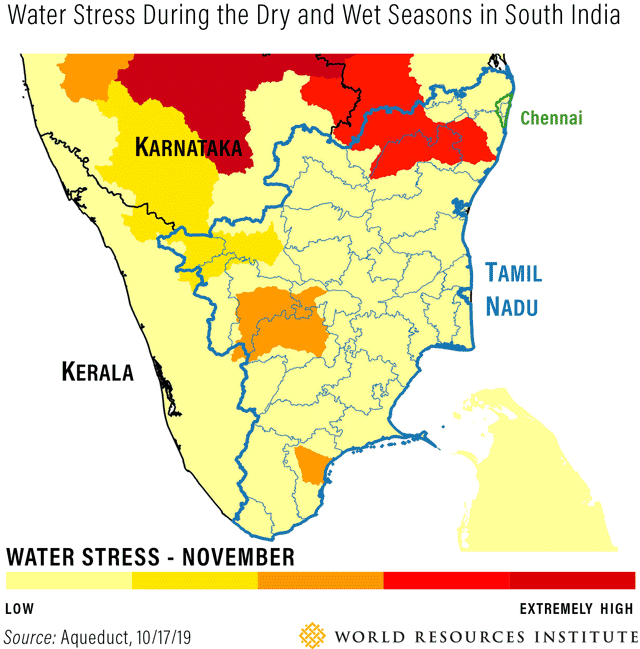
Tamil Nadu state in south India suffers from seasonal extremes in water availability. Sometimes there is too much water, and in other seasons not enough. Chennai, the coastal capital of 10 million people, experienced a “Day Zero” crisis this summer, as its four main reservoirs dried up completely. Yet it also routinely faces severe floods, including record-breaking rains in 2015 that killed hundreds of people. Inland, rural areas saw much the same fate, with heavy rainfall flooding towns and villages in winter months, while droughts stunted crops in others. In 2016, the state suffered its worst drought in 140 years; just a year later a government study found that over 4,000 areas were vulnerable to floods.
There are several reasons Tamil Nadu suffers from both too little and too much water. Examining newly released Aqueduct Water Risk Atlas data on month-to-month water stress (the difference between water demand and available supply) shows that levels change significantly throughout the year. Chennai and much of Tamil Nadu experience extremely high water stress during the average March, typically the height of the dry season. Water stress is at its lowest in November, when the northeast monsoons bring heavy rains.
More alarming still is that, under a business-as-usual climate and growth scenario, seasonal variability in the northeast of the state is expected to increase by an additional 10% by 2040, making it a hot spot of risk in India.
Mitigating climate change is essential to prevent seasonal variability from continuing to increase, as is expected if the current path is unchanged. The state must also prepare to deal with more extreme water variability. Solutions like improving water efficiency, investing in watershed restoration and conservation, and reusing treated wastewater can help improve the outlook for Chennai and other urban areas. For farmers, however, adaptation will be more challenging. Agriculture accounts for 75% of the state’s water use, and farming practices are reinforced not only by existing customs and knowledge, but markets and infrastructure too.
Restoring wetlands, flood plains and other natural lands can help alleviate both sides of Tamil Nadu’s water extremes. These forms of “green infrastructure” provide cities and farmers a buffer from the impacts of floods by absorbing water. They also prevent runoff and allow for recharge of groundwater sources, which increases available water supply.
Explore data on the seasonal variability of water supply on Resource Watch.
Leah Schleifer is the Communications Specialist for WRI’s Water Program.
Raj Bhagat Palanichamy is a Senior Project Associate working on GIS and remote sensing for WRI India Ross Center for Sustainable Cities.
Eric Mackres is the Data and Tools Manager for Urban Efficiency & Climate at WRI Ross Center for Sustainable Cities.








